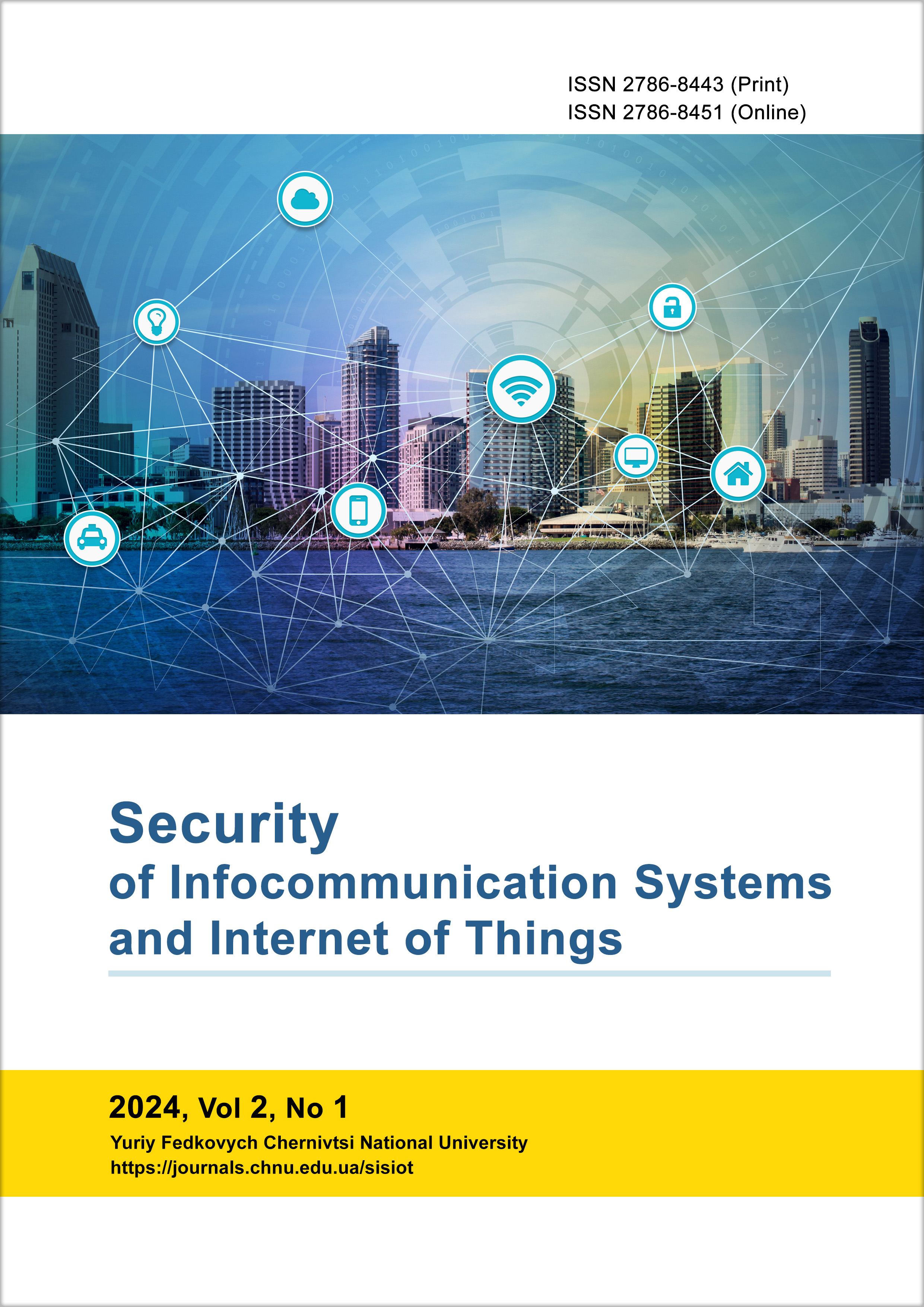Justification of Filter Selection Methods for Enhancing the Efficiency of Multilevel Recurrent Time-Frequency Segmentation
DOI:
https://doi.org/10.31861/sisiot2024.1.01006Keywords:
Butterworth filters, Chebyshev filters, Bessel filters, Kaiser filters, elliptic filtersAbstract
The article examines the issue of substantiation of filter selection methods to increase the efficiency of multi-level recurrent time-frequency segmentation in cognitive telecommunication systems. The main attention is paid to the analysis of signal filtering methods to improve the quality of data transmission in the dynamic conditions of the radio environment. The purpose of the article is to evaluate the effectiveness of various filtering methods for segmentation of ensembles of complex signals. The methods described in the article include Butterworth, Chebyshev, Bessel, Kaiser, elliptic, and hybrid filters. Experiments have shown that different filters have their own unique advantages: Butterworth filters provide a smooth frequency response without ripple in the passband, which reduces signal distortion, increasing the signal-to-noise ratio (SNR) to 45 dB and reducing harmonic distortion to 0.05%. Chebyshev filters, thanks to the steep rolloff in the stopband, increased the SNR to 40 dB, although they have ripples in the passband, which can lead to some phase distortion, with a harmonic distortion reduction of up to 0.07%. Bessel filters minimize phase distortion, providing the lowest group delay (0.04 ms) of any filter, increasing SNR to 42 dB and reducing harmonic distortion to 0.04%. Kaiser filters provide high tuning flexibility, increasing SNR to 44 dB and reducing harmonic distortion to 0.06%, with a group delay of 0.05 ms, which is acceptable for the balance between signal quality and delay. Elliptical filters showed the best SNR improvement up to 48 dB and the lowest harmonic distortion (0.03%), providing ripple levels in both the passband and stopband, making them effective for accurate separation of frequency components. Hybrid filters (Butterworth and Chebyshev) provide the highest level of SNR improvement up to 50 dB, minimum harmonic distortion of 0.02% and optimal adaptability in dynamic environments. The obtained results can be used for the development of more effective cognitive radio networks capable of working in the conditions of a dynamic radio frequency environment. Further research should focus on the development of new hybrid filters and machine learning algorithms to automatically adjust filter parameters in real time, as well as investigating the effect of different types of interference on filtering performance.
Downloads
References
I. M. Baranovska, M. M. Melnyk, and V. V. Koval, "Increasing the Efficiency of Cognitive Radio Networks Based on Adaptive Signal Processing Algorithms," Telecommunication Systems, no. 5, pp. 91-98, 2022.
S. I. Bevs and Y. V. Melnyk, "Optimization of Cognitive Radio Networks Taking into Account Dynamic Changes in the Environment," Bulletin of NTUU «KPI», series “Radiotechnique,” vol. 4, pp. 45-50, 2020.
O. M. Zhdanov and Yu. Yu. Lytvynenko, "Optimization of Signal Processing Algorithms in Telecommunication Systems Using Neural Networks," Bulletin of Kyiv Polytechnic Institute, vol. 10, pp. 33-40, 2021.
S. V. Indyk and V. P. Lysechko, "Study of Ensemble Properties of Complex Signals Obtained by Frequency Filtering of Pseudorandom Sequences with Low Interaction in the Time Domain," Collection of Scientific Works, Kharkiv: HUPS Named After I. Kozheduba, issue 4 (66), pp. 46-50, 2020. DOI: 10.30748/zhups.2020.66.06.
O. O. Trokhymchuk and O. A. Tymoshenko, "Analysis of Parameters of Cognitive Radio Networks Taking into Account Interference Components," Bulletin of the Dnipro National University, vol. 10, pp. 72-80, 2020.
V. O. Fedorchenko and P. P. Savytskyi, Signal Analysis and Processing Systems in Telecommunications, Kyiv: Igor Sikorsky KPI, 2019, 280 p.
V. M. Frolov and A. M. Kotlyar, "Adaptive Signal Processing Algorithms in Conditions of Noise and Interference," Radioelectronics, no. 3, pp. 44-51, 2021.
A. Alsayed, B. Rashed, and H. Hasan, "Adaptive Filtering Techniques for Noise Cancellation in ECG Signals," IEEE Transactions on Biomedical Engineering, vol. 66, no. 2, pp. 519-530, 2019. DOI: 10.1109/TBME.2018.2865017.
H. Arslan, Cognitive Radio, Software Defined Radio, and Adaptive Wireless Systems, Springer, 2007.
W. U. Bajwa, J. D. Haupt, G. Raz, and R. D. Nowak, "Compressed Channel Sensing," in Proceedings of the 42nd Allerton Conference on Communication, Control, and Computing, 2004, pp. 1006-1015.
S. Haykin, "Cognitive Radio: Brain-Empowered Wireless Communications," IEEE Journal on Selected Areas in Communications, vol. 23, no. 2, pp. 201-220, 2005.
M. Honchar, V. Sydorenko, and O. Petrenko, "Advanced Signal Processing Methods in Telecommunication Systems," Lviv Polytechnic National University Journal, pp. 23-37, 2021. DOI: 10.23939/journal.2021.23-37.
Published
Issue
Section
License
Copyright (c) 2024 Security of Infocommunication Systems and Internet of Things

This work is licensed under a Creative Commons Attribution 4.0 International License.









